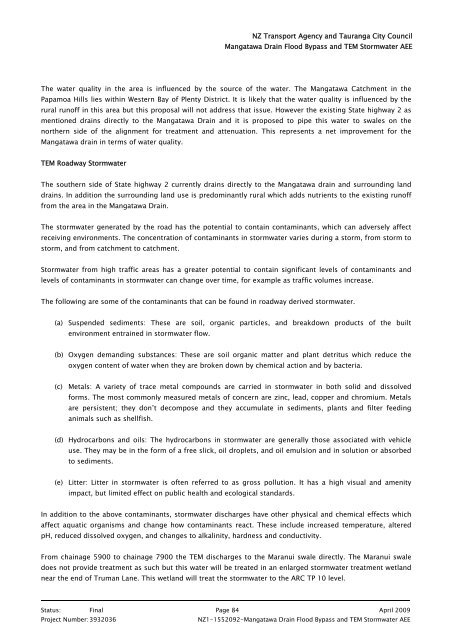2. Mangatawa catchment consents for earthworks, storm water ...
2. Mangatawa catchment consents for earthworks, storm water ...
2. Mangatawa catchment consents for earthworks, storm water ...
- No tags were found...
Create successful ePaper yourself
Turn your PDF publications into a flip-book with our unique Google optimized e-Paper software.
NZ Transport Agency and Tauranga City Council<br />
<strong>Mangatawa</strong> Drain Flood Bypass and TEM Storm<strong>water</strong> AEE<br />
The <strong>water</strong> quality in the area is influenced by the source of the <strong>water</strong>. The <strong>Mangatawa</strong> Catchment in the<br />
Papamoa Hills lies within Western Bay of Plenty District. It is likely that the <strong>water</strong> quality is influenced by the<br />
rural runoff in this area but this proposal will not address that issue. However the existing State highway 2 as<br />
mentioned drains directly to the <strong>Mangatawa</strong> Drain and it is proposed to pipe this <strong>water</strong> to swales on the<br />
northern side of the alignment <strong>for</strong> treatment and attenuation. This represents a net improvement <strong>for</strong> the<br />
<strong>Mangatawa</strong> drain in terms of <strong>water</strong> quality.<br />
TEM Roadway Storm<strong>water</strong><br />
The southern side of State highway 2 currently drains directly to the <strong>Mangatawa</strong> drain and surrounding land<br />
drains. In addition the surrounding land use is predominantly rural which adds nutrients to the existing runoff<br />
from the area in the <strong>Mangatawa</strong> Drain.<br />
The <strong>storm</strong><strong>water</strong> generated by the road has the potential to contain contaminants, which can adversely affect<br />
receiving environments. The concentration of contaminants in <strong>storm</strong><strong>water</strong> varies during a <strong>storm</strong>, from <strong>storm</strong> to<br />
<strong>storm</strong>, and from <strong>catchment</strong> to <strong>catchment</strong>.<br />
Storm<strong>water</strong> from high traffic areas has a greater potential to contain significant levels of contaminants and<br />
levels of contaminants in <strong>storm</strong><strong>water</strong> can change over time, <strong>for</strong> example as traffic volumes increase.<br />
The following are some of the contaminants that can be found in roadway derived <strong>storm</strong><strong>water</strong>.<br />
(a) Suspended sediments: These are soil, organic particles, and breakdown products of the built<br />
environment entrained in <strong>storm</strong><strong>water</strong> flow.<br />
(b) Oxygen demanding substances: These are soil organic matter and plant detritus which reduce the<br />
oxygen content of <strong>water</strong> when they are broken down by chemical action and by bacteria.<br />
(c) Metals: A variety of trace metal compounds are carried in <strong>storm</strong><strong>water</strong> in both solid and dissolved<br />
<strong>for</strong>ms. The most commonly measured metals of concern are zinc, lead, copper and chromium. Metals<br />
are persistent; they don’t decompose and they accumulate in sediments, plants and filter feeding<br />
animals such as shellfish.<br />
(d) Hydrocarbons and oils: The hydrocarbons in <strong>storm</strong><strong>water</strong> are generally those associated with vehicle<br />
use. They may be in the <strong>for</strong>m of a free slick, oil droplets, and oil emulsion and in solution or absorbed<br />
to sediments.<br />
(e) Litter: Litter in <strong>storm</strong><strong>water</strong> is often referred to as gross pollution. It has a high visual and amenity<br />
impact, but limited effect on public health and ecological standards.<br />
In addition to the above contaminants, <strong>storm</strong><strong>water</strong> discharges have other physical and chemical effects which<br />
affect aquatic organisms and change how contaminants react. These include increased temperature, altered<br />
pH, reduced dissolved oxygen, and changes to alkalinity, hardness and conductivity.<br />
From chainage 5900 to chainage 7900 the TEM discharges to the Maranui swale directly. The Maranui swale<br />
does not provide treatment as such but this <strong>water</strong> will be treated in an enlarged <strong>storm</strong><strong>water</strong> treatment wetland<br />
near the end of Truman Lane. This wetland will treat the <strong>storm</strong><strong>water</strong> to the ARC TP 10 level.<br />
Status: Final Page 84 April 2009<br />
Project Number: 3932036<br />
NZ1-1552092-<strong>Mangatawa</strong> Drain Flood Bypass and TEM Storm<strong>water</strong> AEE
















